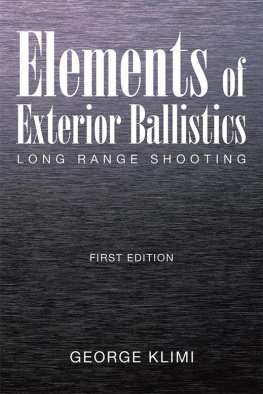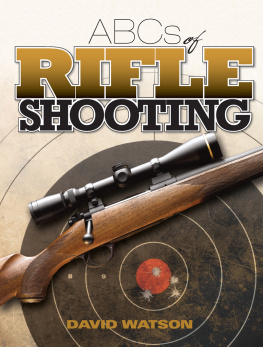L.P. Brezny
Thank you for purchasing this Gun Digest eBook.
Sign up for our newsletter and receive special offers, access to free content, and information on the latest new releases and must-have firearms resources! Plus, receive a coupon code to use on your first purchase from GunDigestStore.com for signing up.
or visit us online to sign up at
http://gundigest.com/ebook-promo
2007 L. P. Brezny
Published by

Our toll-free number to place an order or obtain
a free catalog is (800) 258-0929.
All rights reserved. No portion of this publication may be reproduced or transmitted in any form or by any means, electronic or mechanical, including photocopy, recording, or any information storage and retrieval system, without permission in writing from the publisher, except by a reviewer who may quote brief passages in a critical article or review to be printed in a magazine or newspaper, or electronically transmitted on radio, television, or the Internet.
NOTE: The reloading data cited in this book is presented for informational purposes only. The author and Krause Publications specifically disavow any responsibility for the actual use of such data and recommend that the reader consult reloading tables published by reputable loading component manufacturers.
Library of Congress Catalog Number: 2006935752
ISBN-13: 978-0-89689-471-6
ISBN-10: 0-89689-471-1
eISBN: 978-1-44022-428-7
Designed by Paul Birling
Edited by Derrek Sigler
Printed in United States of America
To
My wife Colleen
It takes special understanding to live life around a gun writer and outdoorsman.
Ross Metzger
My friend and teacher in a complicated subjects dealing with ballistics. He never failed to be there for help and assistance over these many years.
Jim Korzenowski
1943-2005
RIP
When I was about to give up the search for better ideas in ballistics my good friend pushed me on. Thanks, Jimmy.
The shooting sports industry
Without their continued support over these many years, little would have been gained by this writer.
My readers
The most important folks out there in the world of shooting. Without you, there would be no industry or anything to write about!

The Gun Digest Book of
LONG-RANGE SHOOTING
TABLE OF CONTENTS
Chapter 14: Bullet Performance:
The Business End of Long-Range Shooting
Chapter 1
An Overview of
Long-Range Shooting
It was 1964 when the box arrived from the NRA DCM program. That was a program that allowed members of the NRA to buy up military surplus rifles for as little as a 10-dollar bill. My brand new, soaked-in-grease Springfield that had been manufactured in the Remington Arms plant in 1944 had arrived. The rifle was the Springfield 30-06/03 series two-groover. That meant it had been manufactured using a less costly and time-consuming two-groove rifling system that had been found to produce good accuracy, at least in terms of hunting the enemy during WWII. These Springfields had been turned into effective sniper rifles for the task of reaching long-range pill box targets in the island wars of the Pacific, or taking on a German bell tower artillery spotter in a small French town on the other side of the world.

Stripping the military stock, turning back the bolt handle, and removing the iron sights was a start toward this rifles life as a reworked centerfire long-range rifle. With the help of the Herters company, a stock blank with enough wood to allow me to carve a wide, beaver-tail forend was purchased out of the original Waseka, Minnesota stores budget box. A pound of fiberglass bedding compound, sling studs, and a recoil pad finished off the deal.

Author and buddy glassing across a Minnesota swamp in the Spring of 1972 for crow targets. The rifle is an author-rebuiltmilitary 30-06 Springfield. These were very common conversions after the war among hunters and shooters in general.

Author hunting northern California with a pre-1964Winchester Model 70 in 30-06 Springfield. Photo taken in May of 1965.
Without really knowing it at the time, that heavyweight 30-06 shooter was my gateway introduction to the art of long-range shooting. After a months work at the basement workbench, I had the makings of a first-class heavy target rifle.
With an old steel-tube Weaver 10X fixed-power mounted with Weaver bases and rings, and a set of 30-06 dies for my Lyman turret press, I was moving toward the completion of my first long-range rifle. Add some Sierra 150-grain bullets that preceded the current MatchKings, military surplus 4350 powder at 61 grains in GI cases, and I was off to learn the fine art of sending bullets toward long-range crows, woodchucks, badgers and other critters in the random varmint department. My handloads produced a bullet drop at 300 yards of -6.8 inches, allowing me to keep hair on target well out to 350 yards when fox or other, larger critters were in the crosshairs. Even shots to 400 yards were quite often possible, because of the quality Sierra boattail bullets and a good weight balance between the 30-caliber rifle and its matched Springfield barrel. This home-built rifle held accuracy to minute of angle (MOA) at 100 yards. While this was not up to todays standards regarding group size, it was a pretty good shooting stick for a budget-minded young guy who liked to hunt, but was still trying to get through the University of Minnesota, pay the bills, and start a teaching career down the line.
Today you will find that most modern rifles shoot to 250 yards or more with positive accuracy. That means the rifle will hold its bullet groups to at least one inch at 100 yards (MOA). Even the common deer rifle that is sold in the $300 price range today will hold groups to the above-indicated range with ease. Better barrel steel, laser-guided cutting methods, and modern milling processes can turn out accurately milled actions well beyond anything known even as late as 10 years ago. The average rifle trigger today compared to the reworked trigger assemblies used when I started in the business are a far cry from those early two-stage, slack-filled firing pin let-off systems. Nothing about the modern centerfire rifle, be it a standard deer rifle or a long-range varmint/target rig, is even close to those rifles we started with way back in the 1950s and 60s. With the advanced design and manufacturing methods associated with modern rifles, one thing stands out very clear: for the most part, the shooter who wants to get into long-range rifles will not have to invest his life savings.



















